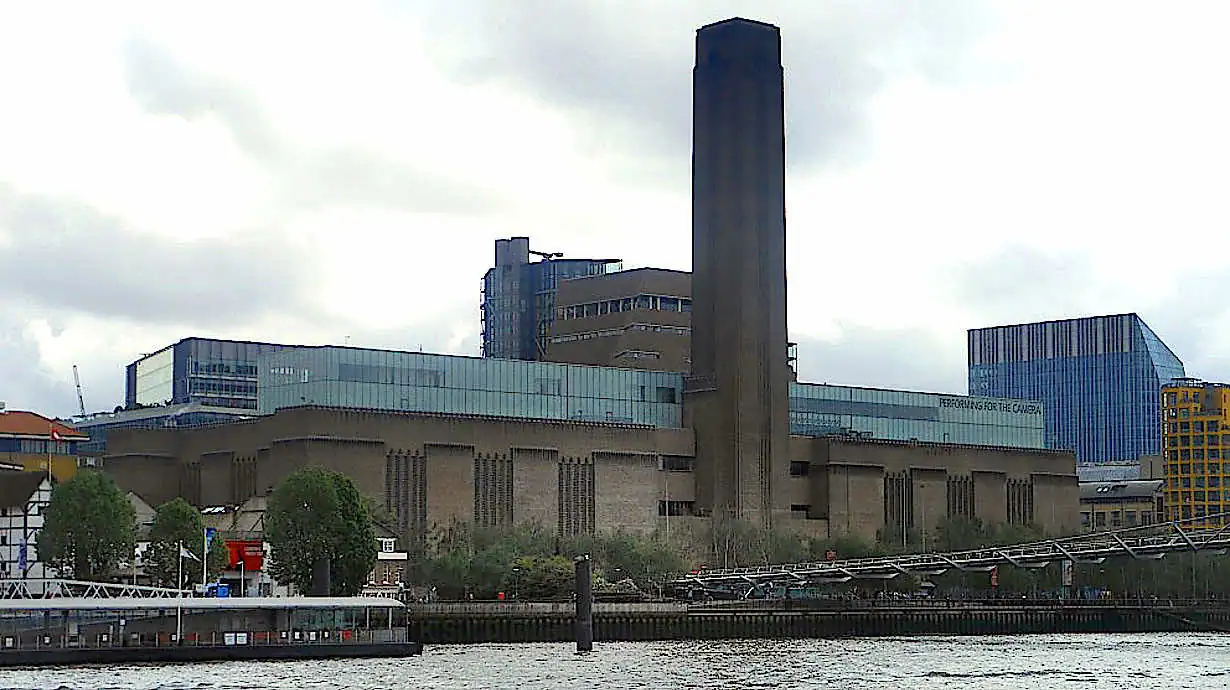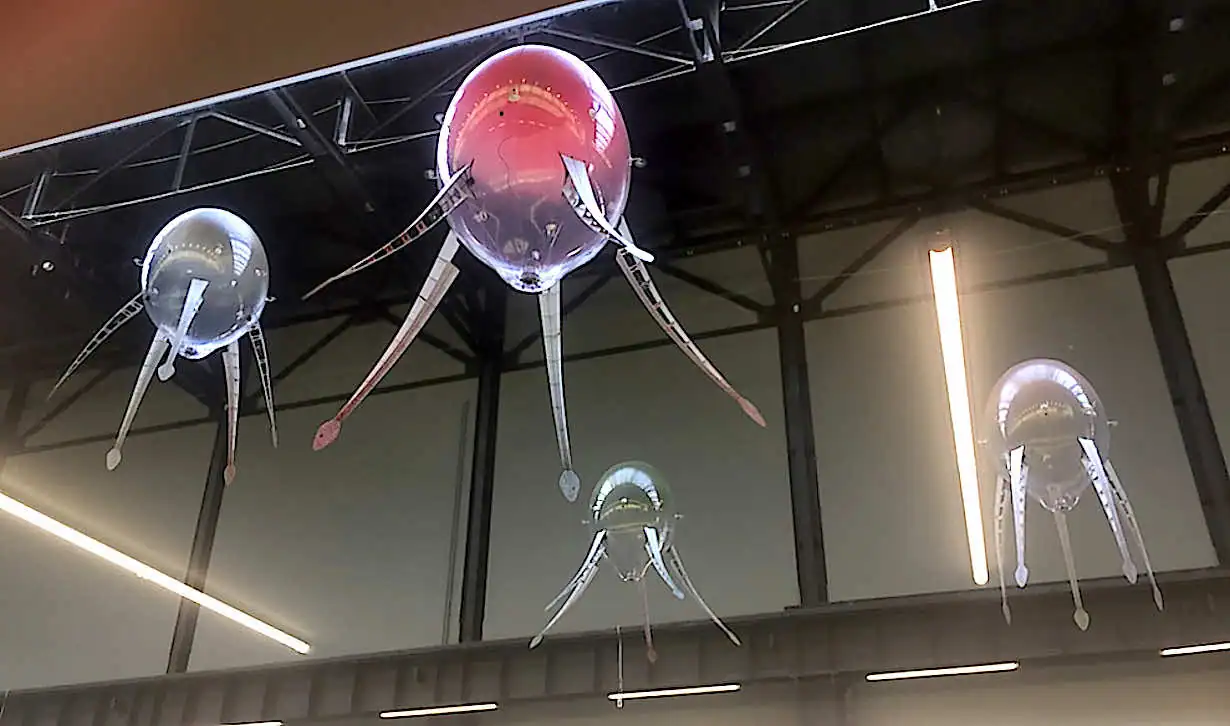
This is supposed to be the most popular art gallery in the country but I think I would have preferred it when it was still a dirty old power station belching smoke over the dome of St. Paul’s.
It’s hard to believe in these days of global COP conferences and zero carbon targets but forty years ago we had Christopher Wren’s 17th-century cathedral on one side of the river and an oil-fired power station on the other. Imagine all the fuel boats and barges unloading down the front – what a sight that must have been! But the only reminder of its previous life now is that cigarette chimney and the abandoned tracks that are still fixed to the ceiling of the Turbine Hall.
Exhibition inside the old power station’s Turbine Hall
 Photo: londondrum.com
Photo: londondrum.comThis central room is so huge that the only thing they can fill it with is nothing, and at the time of writing there are just a few mechanical animals floating around it powered by helicopter rotors and motors. If you peer into it from the big windows upstairs then they look like captured creatures from War of the Worlds.
 Photo: londondrum.com
Photo: londondrum.comI’m normally a bit of a cynic when it comes to modern art but I’m determined to make an effort today because I remember dismissing their famous pile of bricks as filler (Carl Andre, 1966) but I’ve just realised that I’ve spent the last ten minutes admiring the big pile of bricks outside – Giles Gilbert Scott’s 20th-century architecture – so maybe there’s a bit of art in everything if you look hard enough.
Famous modern art paintings and sculptures
 Photo: londondrum.com
Photo: londondrum.comDepending on which route you take through the building the first few rooms are where you’ll find most of the famous names like Magritte, Matisse, Mark Rothko, Roy Lichtenstein’s Pop Art, George Braque’s cubist stuff, Pablo Picasso’s Seated Nude, some surrealist stuff by Salvador Dali, Kandinsky and Klee… I don’t mind looking at these pieces so much because who doesn’t want to see a painting by Picasso? And Jackson Pollock is always worth a look – he’s the only bloke I know who used the skills he learned as a toddler in his adult profession.

But you very quickly realise that for every famous name like Mondrian you’ve got to wade through rooms full of clay turds (Joseph Beuys, 1958), tabletops full of toy cars (Gustav Metzger, 1972) and even an old shopping receipt from the Co-op (Ceal Floyer, 1999).
They start passing off empty frames and blank canvases as actual artworks, and fill the rooms with dirty clothes and bits of bent metal – one of their sculptures is just a piece of galvanised guttering that might have fallen from the roof. Another one is a bathroom urinal. The last time I came here they had a bathroom mirror on display, now they’ve got the urinal. Next time they’ll probably have the taps.

I’m reminded of my A-level art class at school because whenever a pupil couldn’t paint they just filmed themselves staring into a mirror and called it something pretentious like: Youth Crying Out In Anguish Against The Capitalist Hegemony. That’s what the Tate Modern is like – it’s full of artworks like that.
A Coke can on the street is just a piece of rubbish but in here it’s an exhibit… literally. A pile of clothes on your bedroom floor is a mess, but in here it’s a movement. If they hung a sign around the light switch then people would stand there with their thumbs on their chins saying how wonderful it is – it’s that kind of place.
Viewing gallery in the Blavatnik Building
 Photo: londondrum.com
Photo: londondrum.comEven if you’re not particularly interested in the pictures then I think it’s still worth a visit for the exterior views. They’ve got an outside balcony that looks over the mudflats and the Millennium Bridge to the dome of St. Paul’s. Now that is art. Forget all the cr*p on the wall downstairs – if you want to look at something truly impressive then just come upstairs and look out the window.
 Photo: londondrum.com
Photo: londondrum.comAnd best of all is the open-air level at the top of the Blavatnik Building, which has my favourite view of the City skyscrapers from anywhere in London.
 Photo: londondrum.com
Photo: londondrum.comThe Houses of Parliament, Tower Bridge and the Tower of London are mostly blocked off by offices but Canary Wharf looks good in the distance, and you can see all the way out to Alexandra Palace if the clouds don’t turn into curtains.
I also recommend… If you enjoy this then try Hayward Gallery (walk it in 14 mins or travel from Southwark to Waterloo by tube) and Saatchi Gallery (take a tube journey from Southwark to Sloane Square). The two Serpentine Galleries inside Kensington Gardens usually have some contemporary art exhibitions as well. If you’d like to see some more traditional art then try Tate Britain, the National Gallery and Courtauld Gallery
How to get to Tate Modern
| Fare zone | Cash | Oyster & Contactless | Travelcard | ||||
|---|---|---|---|---|---|---|---|
| Single fare | Single fare | Daily cap | One day | ||||
| Peak | Off-peak | Peak | Off-peak | Anytime | Off-peak | ||
| Bus (all zones) | n/a | £1.75 | £5.25 | £6 | |||
| Train (zone 1) | £7 | £2.90 | £2.80 | £8.90 | £8.90 | £16.60(zone 1-4) | £16.60(zone 1-6) |
| Train (zone 1-2) | £7 | £3.50 | £2.90 | £8.90 | £8.90 | ||
| Train (zone 1-3) | £7 | £3.80 | £3.10 | £10.50 | £10.50 | ||
| Train (zone 1-4) | £7 | £4.60 | £3.40 | £12.80 | £12.80 | ||
| Train (zone 1-5) | £7 | £5.20 | £3.60 | £15.30 | £15.30 | £23.60(zone 1-6) | |
| Train (zone 1-6) | £7 | £5.80* | £3.80* | £16.30 | £16.30 | ||
| * Journeys between zone 1 and Heathrow are always charged at the peak rate. Prices are correct as of | |||||||
Related articles and events
Search for art exhibitions in London, art exhibitions today, tomorrow, this weekend and during April and May, or see what’s on on Bankside




 Twitter
Twitter Facebook
Facebook Bluesky
Bluesky WhatsApp
WhatsApp Email
Email






